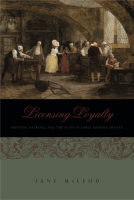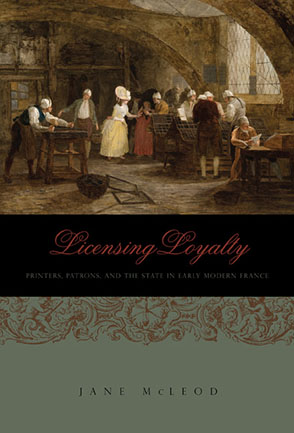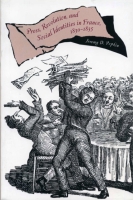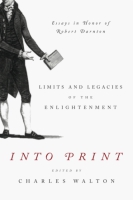Licensing Loyalty
Printers, Patrons, and the State in Early Modern France
Jane McLeod
“Beautifully written, elegantly argued, and extensively documented from archives all over France, Jane McLeod's investigation of how provincial printers were licensed and supervised between the reign of Louis XIV and the French Revolution adds a whole new dimension to our understanding of how the old regime worked. She shows how inadequate it has been to form a view of the world of print from evidence only about Paris and from illicit works produced beyond the kingdom's borders. Her book will now be essential to a fuller understanding of the prerevolutionary public sphere.”
- Description
- Reviews
- Bio
- Table of Contents
- Sample Chapters
- Subjects
“Beautifully written, elegantly argued, and extensively documented from archives all over France, Jane McLeod's investigation of how provincial printers were licensed and supervised between the reign of Louis XIV and the French Revolution adds a whole new dimension to our understanding of how the old regime worked. She shows how inadequate it has been to form a view of the world of print from evidence only about Paris and from illicit works produced beyond the kingdom's borders. Her book will now be essential to a fuller understanding of the prerevolutionary public sphere.”
“Jane McLeod’s detailed research helps us see how interest groups like provincial printers helped construct the Old Regime’s regulatory mechanisms. Deeply enmeshed in local and national networks of patronage, these men—often members of family dynasties—had little reason to favor either free economic competition or subversive new ideas. Challenging widespread assumptions about the role of print media in subverting the monarchy, McLeod shows that the Revolution of 1789 would be a challenge as much for printers as for the officials charged with supervising them.”
“This incisive treatment of provincial printing houses’ relations with the royal government explains how the French monarchy successfully worked with provincial printers to determine publishing policy and control print media throughout France. Jane McLeod challenges conventional views of the ties between the royal state and printers, showing how the state’s policy of issuing a limited number of licenses, traditionally considered a repressive measure, came to find widespread support among the established printer elite. Along with highly useful local monopolies and lucrative government printing contracts, licenses conferred on these fortunate men and women a new, unexpected identity: in addition to their older roles as professionals, guildsmen, and clients of local bishops and judicial officials, they increasingly became lobbyists and supporters of royal ministers, endorsing their policies of state controls on the printing trade and on the flow of ideas. McLeod demonstrates how it was only chance and circumstance that occasionally transformed them into champions of free thought, an identity which in retrospect we too easily and often confer on them, and how thoroughly the provincial printers gradually turned into creatures of the king and his ministers, sharing the ambiguous and contradictory loyalties, interests, and identities so characteristic of eighteenth-century elites.”
“Through carefully constructed case studies drawn from printing centers large and small, McLeod reveals the stakes that locals believed they had in the [licensing] process and how its implementation undercut local authorities. . . .Her close examination of individual printers and family fortunes reveals shrewdness and ruthlessness, discipline and patience—qualities essential to advancing social ambitions over generations. McLeod has exhaustively mined Parisian and provincial archives to compose this meticulous account.”
“Licensing Loyalty will be of great value for those interested in publishing, in guilds and in the growing bureaucratic state. McLeod offers a fresh analysis of printing as a profession by focusing on printers’ routine activities over a century, rather than their exceptional moments of controversy, and she adds substantively to our understanding of both the emerging bureaucratic state and one of the central venues of Enlightenment culture.”
“[Licensing Loyalty] provides a detailed picture of the interests, discourses, actions, and relationships of printers throughout France under the Old Regime. This picture furthers our understanding not just of the book trade but of the state-building process in the century and a half between the end of the Wars of Religion and the beginning of the French Revolution. It is thus relevant to scholars of print culture, absolutism, and Enlightenment in early modern Europe.”
Jane McLeod is Associate Professor of History at Brock University in Ontario, Canada.
Contents
Acknowledgments
Introduction
1. The Early History of Printers in Provincial France, 1470–1660
2. The Vicissitudes of a Royal Decree: Enforcing the October 1667 Order in Council Regulating Printers in the Provinces
3. The Royal Council Takes Control: The 1701 Inquiry and the Bureau de la Librairie
4. The Purges: The Enforcement of Printer Quotas in the Provinces After 1704
5. Arguments Offered by Printers in Petitions for Licenses, 1667–1789
6. Patronage and Bureaucracy Intersect: Five Case Studies in the Reign of Louis XVI
7 . Behind the Rhetoric: The Social Position and Politics of Provincial Printers, 1750–1789
Conclusion
Appendix A: Printers’ Wealth in the Eighteenth Century
Appendix B: Some Licensed Provincial Printers Involved in the Clandestine Book Trade, 1750–89, by Town
Notes
Bibliography
Index
Introduction
On an October afternoon in 1780, three Dijon notables met at the printers’ and booksellers’ guildhall to preside over a competition to fill a vacant position for a printer in their town.1 The competition had been ordered from Versailles by Armand Thomas Hüe de Miromesnil, the keeper of the seals, who had instructed the intendant of Dijon to publicize it widely by putting up posters not only in Dijon but in all the towns in the area as well.2 The inspector of the book trade in Dijon joined the three officials to oversee the candidates’ performance in an examination conducted by the guild warden and two other printers. The event that occasioned the meeting of all these men was the decision of Anne Foucherot, the widow of Antoine Defay, to give up her position as printer in Dijon. She had submitted her resignation to Miromesnil, who then received a petition from her son, Antoine-Marie Defay, requesting the position. Miromesnil and Le Camus de Néville, the director of the book trade, decided to fill the vacancy by the competition. After one of the two printer-examiners declared a conflict of interest and withdrew, the examination began in earnest with the first question: “What is a printing house and what does it comprise?”
Defay passed the test. After answering some forty questions, he composed a page from a manuscript copy, proofed it, and distributed it to those present. He then repeated the exercise in different-sized fonts. His examiners deemed the pages correct and the examination complete. They then went to the door of the guildhall and called out several times to see whether there were any other candidates to be examined. There were none. By 7:00 in the evening, the meeting was over. A report of the result was sent to Versailles, where Le Camus de Néville and the masters of requests assigned to Defay’s dossier could scrutinize it and advise Miromesnil on whether he should grant Defay a license to become a printer.
Officially, Le Camus de Néville had the following information to work with. First, he had Defay’s own story: he was thirty-two years old and had completed his formal education, followed by an apprenticeship with his now-deceased father, who had been a printer-bookseller in Dijon. After that, he had directed the family’s printing house for more than eight years.3 His mother was sure enough of her son’s knowledge of the art of printing and confident enough that her son would be chosen to succeed her that she was willing to resign her printer’s license. Second, Defay provided the following documentation: a certificate of competence from the printers’ guild, his baptismal certificate, and affidavits from his priest and the lieutenant of police stating that Defay had been printing since childhood, that he directed his father’s printing house, and that he had always behaved in an irreproachable manner. Defay also included references from a grammarian establishing that he was educated and had studied with the Jesuits. In addition, a certificate from the prefect of the College of Dijon confirmed that Defay had completed two years of study there. Defay supplied the minutes of his printing examination, signed by the guild officers, showing that he had satisfied the requirements for obtaining printing licenses outlined by a royal decree in 1777. Defay ended his petition with the request that the king order his swearing-in before the lieutenant of police, thereby admitting him as printer-bookseller in Dijon in place of his mother. On Le Camus de Néville’s recommendation, Miromesnil approved the request, and an order in council was issued by the king’s privy council on 18 December 1780.4
The following month, the same Dijon notables assembled at an extraordinary meeting of the printers’ and booksellers’ guild in Dijon to hear the reading of the royal order in council admitting Antoine-Marie Defay to a printer place in Dijon. Defay then requested its registration in the Dijon guild register, and a vote was taken. Guild members unanimously agreed to register and transcribe the order in council into their minutes. Defay promised to pay the Dijon guild warden the sum of 600 livres, of which 200 would go to the guild (which already had 100 livres from him when he was accepted earlier as a bookseller) and 300 would be put into a special fund used by Miromesnil to pay the book trade inspector.
The keeper of the seals, the director of the book trade, the intendant, the lieutenant of police, the inspector of the book trade, and the guild officials in Dijon were all involved in these proceedings in accordance with the procedures for printer appointment laid out in detail by a royal order in council on 30 August 1777.5 These procedures represent the mature development of the French monarchy’s century-long policy of licensing—and consequently determining—those who would hold roughly 310 positions authorized in the realm. Licensing began in 1667 when Louis XIV’s minister, Jean-Baptiste Colbert, banned all new printers in provincial towns from setting up without special approval.6 In the following years, printers in some towns saw great advantages to be gained from royal licensing policies and made sure that the law was implemented. In other towns, the licensing requirement went unnoticed until 1704, when royal officials set quotas on the numbers of printers allowed in each town and ordered the lieutenants of police to enforce them.7 In subsequent decades, the number of printers was forcibly reduced. By 1739—when the rules were tightened and the number of printers was again reduced—there was wide acceptance of printer licensing. In 1759 the numbers were further reduced, and in 1777 the procedures for printer appointment were clarified.
Despite the appearance of bureaucratic decision making, there was never any doubt about who would fill the vacant printer position in Dijon in 1780. It was the theatre of these two days that gave these events their meaning. The selection of a French printer was several things all at once: a guild voting to accept a colleague, the passing of a family office from one generation to the next, an event in municipal politics, an instance of royal patronage, and, finally, a harbinger of a modern bureaucratic tradition with examinations based on merit. These layered meanings all have their own histories and are part of the story of state-media relations in early modern France.8 Printers just outside French borders have attracted the attention of many scholars who believe that the importation and sale in France of books published abroad helped prepare the way for the French Revolution—an idea that may have resonated strongly with a generation of American historians that came of age during the Cold War.9 In contrast, political historians of eighteenth-century France have tended to regard domestic French printers as a rather subservient group and consequently of little interest.10 Licensing Loyalty challenges this perception by suggesting that the relative absence of persecution of French provincial printers in the regular courts in the eighteenth century is itself a story worth telling. It reveals the very successful way in which printers managed to build multiple identities that allowed them to fit the changing economic, religious, and political realities of eighteenth-century France.
In the sixteenth and seventeenth centuries, printers were clients of a variety of political and religious bodies: the parlements, the king, the universities, the bishops and archbishops. Because it was difficult or impossible to avoid engagement with political factions, printers were vulnerable to persecution during political conflicts, and they relied on patrons for protection. During the Wars of Religion in the sixteenth century, there were Protestant printers, League printers, and many who changed sides. In the political struggles surrounding the calling of the Estates General in 1614–15, individual printers—such as Jean Janon in Sedan, a client of the duc de Bouillon—depended on their protectors.11 During the Fronde, relations between printers and their protectors evolved in a variety of ways. The rebel prince of Condé’s printers were among several who printed mazarinades; other printers, however, remained loyal to the Court.12 Later in the seventeenth century some famous Parisian printers worked for the Jesuit cause, and the printers of Port Royal also had their protectors.13 When the Parisian publisher Guillaume Desprez, for example, was arrested in 1657 for publishing Jansenist works, he could count on supporters who used their influence with the lieutenant of police to help him escape the Châtelet’s severe justice. A quick look at how Pascal’s Provincial Letters were published shows printers and booksellers relying on powerful bishops and parlementaires to protect them from Jesuit pressure on Chancellor Séguier.14 In an era when political printing could be dangerous, printers were clients of powerful factions and were accorded a high degree of protection.
Much historical writing, however, gives the impression that printers’ earlier political alliances had disappeared by the eighteenth century. The standard explanation for why this happened in Paris is that the royal government imposed a series of controls during the reign of Louis XIV and subjected the city’s printers to its direction. The Paris story has been well known since Henri-Jean Martin told it some forty years ago. He argued that a series of midcentury crises provoked Colbert to bring printing, publishing, and bookselling directly under the king’s control.15 Between 1643 and 1667 several crises coalesced: internal strife in an overpopulated and undisciplined book guild, quarrels between Jansenists and Jesuits, conflicts over monopolies on titles and their renewal, labor difficulties, high paper costs, the Fronde, foreign competition, pirating, and trade wars. Faced with these threats to what had been a healthy book trade, the authorities were forced, in what Martin calls la réaction royale, to impose supervision on the printers. Control was established in two well-known ways: by censoring works in advance of publication and by granting monopolies to favored printers. In addition, the government reduced the number of printers in Paris to thirty-six, placing all of them under the supervision of the lieutenant of police, a newly created post then held by Gabriel-Nicolas de La Reynie. By the end of the reign of Louis XIV, Parisian printers found themselves more subservient to the king than ever before.
Martin’s subject was Paris; he said little about printers in the French provinces, and what he did say implies a top-down application of control to the provinces, when there was any at all.16 The present study tells the story of the relations between printers in towns outside Paris with local authorities and with royal officials, from the reign of Louis XIV until the French Revolution. The Sun King’s reign was critical in establishing royal authority over the media but, outside Paris, it was only late in the reign—especially during the tenure of Pontchartrain as chancellor—that the government began to establish its authority over printers in an unprecedented manner. Yet this development, far from consigning printers to the margins of historical interest, opened up a new era in their lives that is important to examine. Control was only possible with the considerable and active cooperation of the printers themselves. From the beginning of the eighteenth century, the establishment of the Bureau de la librairie created two-way communication between French provincial printers and royal officials that fundamentally changed—through persuasion, negotiation, bribery, and repression—the relations between printers and the government. Printers were more closely supervised through this process than in earlier centuries, but it would be wrong to suggest that they responded passively to these changes. That is the impression that printers created in their rhetoric, but we should not allow them to mislead us. What they did was create a new role for themselves as loyal agents of monarchy. Guild rhetoric and the rhetoric of absolutism coincided to create the persona of the loyal licensed printer, one that stood in contrast to disloyal outsiders who shared the ways of a disordered, immoral, and dangerous world. This dichotomy was continuously emphasized by Parisian and other licensed printers in their denunciation of the unregulated trade. The survival of feudal notions of loyalty, coupled with the ideology of absolutism, made it easy for these printers to believe their own rhetoric; their incessant appeals to fear influenced government officials who worried that an unregulated press threatened French Christian society. This idea was self-serving but very influential with French officials.
In taking on and exploiting this new identity as “pillars of monarchy,” however, printers did not abandon their older identities. Instead, unconcerned about the problems of competing loyalties, conflicts of interest, or inherent contradictions, printers added yet another identity to other historic identities that they had exploited since the advent of print—as clients of patrons, as members of guilds, as members of universities, and as local businessmen.17 Printers held onto the privileges and status offered by their previous associations and at the same time began taking advantage of those offered by their new, more intimate relationship with the developing royal administration. By 1780, when Antoine-Marie Defay was applying for his license, at least three generations of printers in his family had made careers by presenting themselves to the authorities in Versailles as loyal pillars of monarchy while keeping up their loyalties to other constituencies. Given the number of people involved in Defay’s nomination as a printer, it is worth pondering who was absent from the proceedings. One missing figure was the bishop, often an important force in a provincial printer’s life. Significantly, many others had a role.
Officials were aware that the king’s subjects were not as unambiguously loyal as they liked to pretend, and they were also aware of printers’ loyalty to nobles and bishops.18 Consequently, the state offered privileges to printers that confirmed their special status, made them wealthy, and tied their fortunes to a strong monarchy.19 When this failed, royal officials used repression to deter printers from being disloyal.20 The horrific burning or execution of printers in earlier eras disappeared in the eighteenth century, but persecution did not. A number of studies have looked at the printers in the Bastille, a group that included Voltaire’s publisher in Rouen and the publisher of the Encyclopédie, André-François Le Breton. What is clear is that spectacular court cases of printers tried in the regular courts were very rare because, from early in the eighteenth century, the infractions of licensed printers were not generally matters for the regular courts. Rather, they were handled administratively by royal officials. Chancellors or keepers of the seals, responding to information from the intendants and officials in the Bureau de la librairie, tried and punished printers directly for book trade infractions. These royal administrators not only ordered searches and seizures of books but also fined, suspended, and expelled printers and booksellers from their trades. In the second half of the eighteenth century, new officials called “inspectors of the book trade” helped royal officials implement the large body of legislation designed to control both domestic printing and the import of books from abroad.
In the history of censorship, a central idea commanding considerable support among historians is that censorship ceased to work properly in France in the eighteenth century: while under Louis XIV government control of printing and bookselling was somewhat successful, by the eighteenth century weakness had set in, either because the Enlightenment made officials more tolerant or because the government became weak.21 The great historians of France and others more specialized in the history of censorship all say this in one way or another, as do almost all general studies and textbooks. The idea is drawn from studies of how and why the state chose the books it deemed acceptable and what controversies resulted from these choices. We are all influenced by Denis Diderot’s utter disdain for a system that he mocked by turning it on its head, saying that writers were never happier than when their books were banned, because that only gave them higher prices and more sales. Nor can we be indifferent to one of the great minds of the century, Chrétien-Guillaume de Lamoignon de Malesherbes, director of the book trade between 1748 and 1763, who famously claimed that anyone who read only what was legal was a century behind the times. Furthermore, the controversies over whether to ban some of the famous works of the Enlightenment, notably those over the Encyclopédie and over Claude-Adrien Helvetius’s De l’Esprit, suggest that the state was confused and ineffective. Research into the prior censorship mechanisms in eighteenth-century France has addressed many important questions. What were the criteria for permitting or banning titles and generally for deciding on suitable reading for the French people? What problems did the decision makers face? Was there some fundamental incompatibility between the functioning of absolute monarchy and what urban literate elites were reading and thinking? Was a developing liberalism reflected in the introduction of unofficial permissions, known as permissions tacites, and in the career of the well-known liberal Malesherbes as director of the book trade?22 With the Revolution looming up in 1789, much of this interest has been teleological: a failure of censorship is needed to explain the political crises of the late ancien regime.
The theme of this book is different. It is not about the ways in which French officials decided what they would let the French public read. Nor is it about repression, but rather about one of the ways they tried to implement royal policy on the ground by cultivating obedience among provincial printers. Beginning with the introduction of a system of licensing printers in the provinces in 1667, French kings established and elaborated a wide-ranging set of mechanisms of communication with provincial printers and encouraged them to care about the royal government in Versailles, much as nobles were brought to care about it in the seventeenth century. The encouragement of loyalty and the enforcement of royal laws in the French provinces are central subjects in this book, making it more a contribution to the social and political history of France than to the cultural or intellectual histories that most often investigate printers. Policing the book trade in an early modern state was a difficult task when police forces were small. Even in the best policed town of the period, Paris, manpower was limited; outside the capital, the task was truly daunting. Controlling books was impossible without the cooperation of the booksellers and printers themselves, and the eighteenth-century state obtained significant cooperation from the printers, who came to see state regulation in positive terms. Cooperation from the provincial printers evolved, over time, into their active lobbying to expand their own regulation. Government officials, who arguably had their hands full in levying taxes, provisioning towns, and taming riots, nevertheless came to care deeply about book trade regulation and to fear seditious books and pamphlets. The policing of the book trade was increasingly regarded as vital to the interests of the state and therefore in need of supervision, not unlike the grain trade or the navy.23
The aim of this study is, therefore, to examine the government’s attempts to develop a mutually beneficial relationship with France’s provincial printers and to assess its success. It is the first detailed presentation of the French government’s licensing policy. It offers new evidence on how both officials and printers themselves understood the issue of media control and how they influenced each other, gradually building a distinct view of the dangers of the printed word. This study also sheds new light on some larger issues, such as the extent to which French absolutism was negotiated rather than imposed, the role of lobbying behind royal legislation, and the development of bureaucracy. The following pages show that the policy was not a failure but, in fact, quite transformed the world of provincial printing by concentrating printing in the hands of a number of well-known men and women who became wealthy notables in their towns. One of the purposes of licensing was to keep authorized printing out of the hands of the poor and needy and, in this regard, it was a complete success. As a means of ensuring loyalty, however, its success was more limited; the loyalty it engendered was not resilient enough to withstand the enormous influence of the parlements over public opinion during the constitutional crises under Maupeou (1770–74) and in what has been called the Pre-Revolution (1787–89). Much of the criticism in these political struggles emanated from within the provincial towns’ elites, which, by the late eighteenth century, included printers and their families. Many of these printers had especially close ties with the judicial world and could not avoid the conflicting influences of their milieu. But all through the period before 1789, printer licensing showed no sign of weakening or crumbling until the Revolution swept it away.
Chapter 1 traces the spread of printing into the French provinces following the advent of print and presents the five different identities the practitioners of the new art constructed for themselves in their communities. Chapter 2 shows how the Paris printers framed the problem of ideological control for royal officials who were faced with the challenges of the Fronde and Jansenism in the seventeenth century. It examines the first royal law—an order in council in October 1667—that reversed earlier royal efforts to encourage the proliferation of printer establishments in the French provinces and ordered the licensing of provincial printers. Chapter 3 is a study of the Bureau de la librairie, its creation, its functioning, and the activities of some of its major officials up to 1789. Chapter 4 is an analysis of the effects of an order in council issued in 1704 that set quotas on the number of printers in every French town, radically altering the lives of printers in provincial France. With the advent of licensing, printers began making written arguments evoking family, property, gender, loyalty, and protection in their petitions to royal officials in order to obtain licenses. Chapter 5 analyzes these arguments. Chapter 6 provides case studies of a few major provincial printers, revealing their close and direct ties with Versailles officials. The licensing policy improved the wealth and social status of provincial printers generally in France, as shown in chapter 7, but failed to secure the loyalty of many printers. This book is about lobbying and about the creation and propagation of the idea of loyalty in early modern France—in an era when the notion of a “free press” was only notable for its absence.
Also of Interest
Mailing List
Subscribe to our mailing list and be notified about new titles, journals and catalogs.






